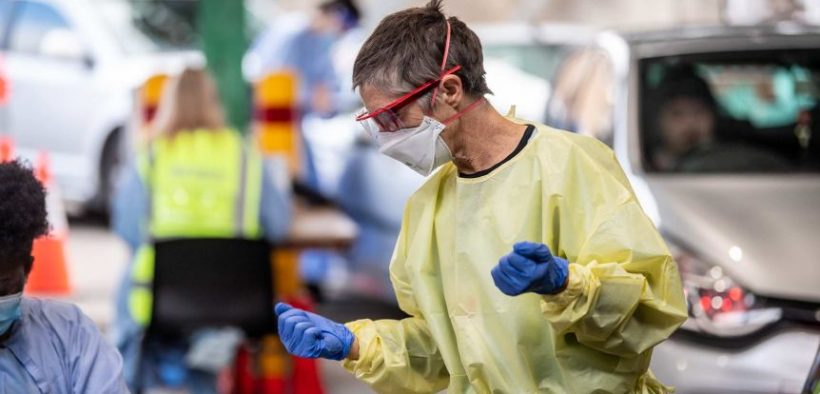New NSW COVID-19 cases likely 10 times higher than official figures: expert

The number of new COVID-19 cases in New South Wales each day is likely to be up to 10 times the figure reported by authorities, according to one epidemiologist, as fears about community transmission in the state grow.
Key points:
- Experts say there are undetected cases of community transmission in NSW
- While Victoria has widespread community transmission, NSW is working to keep numbers contained
- Experts say two weeks of mandated mask use would help stop asymptomatic and pre-symptomatic cases from spreading
University of Melbourne epidemiologist Tony Blakely said the presence of cases without a known source was “a good signal” actual case numbers were a lot higher.
“So, if they’ve got an average of 20 [cases per day] in the last week, that means that at any one point in time, there’s about 200 other cases out there that we don’t know about. Basically, 10 times the daily count,” Professor Blakely said.
He said some of those cases would have an identifiable source, but others would be “mystery cases”.
“If you’ve got a case that pops up and you can’t trace it back to its source, and you assume that tracking has been done well … it means it’s come from silent transmission.”
On Thursday, NSW reported 12 new cases of COVID-19, including three that were acquired locally without a known source.
Leading epidemiologist Mary-Louise McLaws agreed NSW had some level of undiagnosed transmission of COVID-19, with at least one undiagnosed case for every diagnosed person.
“I am not sure I would put it as high as 200, but I accept the argument that for every diagnosed person, there is probably at least one other that we don’t know about, or possibly two or three,” Professor McLaws said.
“There are probably at least 20 cases that we are not aware of because it takes people a while to realise they are unwell and to get tested.”
This morning, NSW Premier Gladys Berejiklian told Channel Seven mystery cases worried her the most.
“We’re concerned there’s community transmission we haven’t picked up,” she said.
“We’re doing well, we’re holding our own, but when every week you get a couple of unknown cases and they can’t be linked, you do worry because what it does tell us is that there is the disease circulating.”
Up to a third of all the infected people are “silent transmitters” who do not show any symptoms, Professor Blakely said.
“And then there are other people who are also silent transmitters who are so mildly symptomatic [that] they don’t realise they have it,” he said.
Both experts noted people who had COVID-19, but were pre-symptomatic, would be spreading the virus unknowingly before symptoms hit, contributing to community transmission.
“Eventually, a chain of transmission that is silent will end up with a case that’s symptomatic. Someone … is going to get crook enough to present with symptoms and get tested,” Professor Blakely said.
Professor Blakely said after a couple of weeks of cases reappearing, it was “almost inevitable” some of those would be “mystery cases” without a known source. NSW has a suppression strategy, so some new cases are to be expected, but to move to elimination, the state’s response would have to be very different.
New Zealand gives a perfect example of what you do when a mystery case pops up and you want to maintain elimination or get to elimination — you go hard and you go early,” Professor Blakely said.
“You need to hit it that hard to get ahead of the virus and stop transmission and stamp out all cases, including both the ones [where] you’ve been able to find where they come from, [and] the silent mystery cases.”
NSW has a different strategy, one that aims to keep the caseload at a “manageable amount”. And if authorities can manage to keep case numbers down, Professor Blakely said it would provide a “blueprint”.
“NSW is running a game at the moment whereby they’re accepting there will be ongoing community transmission and they want to keep it low,” he said.”The suppression strategy allows you to keep your economy open, but there’s always a risk it’s going to explode in your face.” Masks critical to stop COVID-19 ‘wildfire’



















